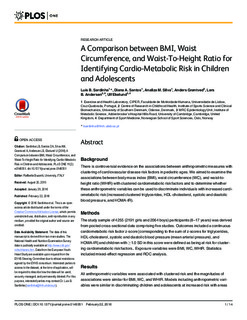| dc.contributor.author | Sardinha, Luis B. | |
| dc.contributor.author | Santos, Diana A. | |
| dc.contributor.author | Silva, Analiza M. | |
| dc.contributor.author | Grøntvedt, Anders | |
| dc.contributor.author | Andersen, Lars Bo | |
| dc.contributor.author | Ekelund, Ulf | |
| dc.date.accessioned | 2017-01-19T13:57:16Z | |
| dc.date.available | 2017-01-19T13:57:16Z | |
| dc.date.issued | 2016-02-22 | |
| dc.identifier.citation | PLoS ONE. 2016, 11, 1-14. doi: http://dx.doi.org/10.1371/journal.pone.0149351 | nb_NO |
| dc.identifier.uri | http://hdl.handle.net/11250/2427857 | |
| dc.description.abstract | BACKGROUND: There is controversial evidence on the associations between anthropometric measures with clustering of cardiovascular disease risk factors in pediatric ages. We aimed to examine the associations between body mass index (BMI), waist circumference (WC), and waist-to-height ratio (WHtR) with clustered cardiometabolic risk factors and to determine whether these anthropometric variables can be used to discriminate individuals with increased cardiometabolic risk (increased clustered triglycerides, HDL-cholesterol, systolic and diastolic blood pressure, and HOMA-IR). METHODS: The study sample of 4255 (2191 girls and 2064 boys) participants (8-17 years) was derived from pooled cross-sectional data comprising five studies. Outcomes included a continuous cardiometabolic risk factor z-score [corresponding to the sum of z-scores for triglycerides, HDL-cholesterol, systolic and diastolic blood pressure (mean arterial pressure), and HOMA-IR] and children with ≥1.0 SD in this score were defined as being at risk for clustering cardiometabolic risk factors.. Exposure variables were BMI, WC, WHtR. Statistics included mixed-effect regression and ROC analysis. RESULTS: All anthropometric variables were associated with clustered risk and the magnitudes of associations were similar for BMI, WC, and WHtR. Models including anthropometric variables were similar in discriminating children and adolescents at increased risk with areas under the ROC curve between 0.70 and 0.74. The sensitivity (boys: 80.5-86.4%; girls: 76.6-82.3%) was markedly higher than specificity (boys: 51.85-59.4%; girls: 60.8%). CONCLUSIONS: The magnitude of associations for BMI, WC, and WHtR are similar in relation to clustered cardiometabolic risk factors, and perform better at higher levels of BMI. However, the precision of these anthropometric variables to classify increased risk is low. | nb_NO |
| dc.language.iso | eng | nb_NO |
| dc.publisher | PLOS | nb_NO |
| dc.subject | body mass index | |
| dc.subject | anthropometry | |
| dc.subject | adolescents | |
| dc.subject | obesity | |
| dc.subject | children | |
| dc.subject | childhood obesity | |
| dc.subject | blood pressure | |
| dc.subject | pediatrics | |
| dc.title | A comparison between BMI, waist circumference, and waist-to-height ratio for identifying cardio-metabolic risk in children and adolescents | nb_NO |
| dc.type | Journal article | nb_NO |
| dc.type | Peer reviewed | nb_NO |
| dc.subject.nsi | VDP::Matematikk og Naturvitenskap: 400::Basale biofag: 470 | nb_NO |
| dc.subject.nsi | VDP::Landbruks- og Fiskerifag: 900::Landbruksfag: 910 | nb_NO |
| dc.source.journal | PLoS ONE | nb_NO |
| dc.identifier.doi | http://dx.doi.org/10.1371/journal.pone.0149351 | |
| dc.description.localcode | Seksjon for idrettsmedisinske fag / Department of Sports Medicine | nb_NO |
